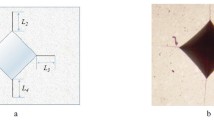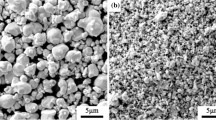Abstract
With the wide application of cemented carbide, W and Co, the main raw materials for preparing cemented carbide, are depleted increasingly. Therefore, it is more and more important to prepare regenerated cemented carbide by recycling WC scrap. However, in the preparation of regenerated cemented carbide, there will be problems such as the introduction of impurity elements, discontinuous growth of grains, and high porosity. To optimize the mechanical properties of the regenerated cemented carbide, the modification of regenerated cemented carbide by adding rare earth oxides has been studied. It is found that the addition of rare earth can effectively inhibit the growth of WC grains and the formation of pores, thus avoiding the abnormal growth of WC grains. With the increase in the rare earth oxide content, the relative density, hardness, and bending strength of regenerated cemented carbide show a trend of increasing first and then decreasing. Among them, the addition of 0.5% Y2O3 has the optimal effect on improving the mechanical properties of regenerated cemented carbides. The relative density, hardness, and strength have been increased by 1.24, 9.43, and 11.37%. When the content of rare earth is more than 0.7%, the comprehensive properties of regenerated cemented carbide begin to decline.















Similar content being viewed by others
References
A. Shemi, A. Magumise, S. Ndlovu, and N. Sacks, Recycling of Tungsten Carbide Scrap Metal: A Review of Recycling Methods and Future Prospects, Miner. Eng., 2018, 122, p 195–205.
R.R. Srivastava, J.-C. Lee, M. Bae, and V. Kumar, Reclamation of Tungsten from Carbide Scraps and Spent Materials, J. Mater. Sci., 2018, 54, p 83–107.
X.H. Zhou, L.M. Wang, and Y.J. Peng, The Status and Development of China’s Cemented Carbide Recycling Industry, Cem. Carbide, 2016, 33(5), p 356–364.
B. Yang, G.J. Chen, A.H. Shi et al., Research Status of Short-Process Recycling Technology of Waste Cemented Carbide, Mater. Guide, 2015, 29(3), p 68–74.
Y. Wang, X.Y. Song, Y.M. Liu et al., Oxidation-Reduction Carbonization Method for Recycling High-Performance Cemented Carbide, Rare Met. Mater. Eng., 2014, 43(12), p 3172–3176.
B. Uhrenius, B.-W. Hélène, and U. Gustavsson, On the Formation of Impurity-Containing Phases in Cemented Carbides, Int. J. Refract. Met. H, 1991, 10(1), p 45–55.
T. Kojima, T. Shimizu, R. Sasai et al., Recycling Process of WC-Co Cermets by Hydrothermal Treatment, J. Mater. Sci., 2005, 40, p 5167–5172.
N. Lin, Y. Jiang, D.F. Zhang et al., Effect of Cu, Ni on the Property and Microstructure of Ultrafine WC-10Co Alloys by Sinter–Hipping, Int. J. Refract. Met. H, 2011, 29, p 509–515.
I. Konyashin, S. Hlawatschek, B. Ries et al., On the Mechanism of WC Coarsening in WC-Co Hardmetals with Various Carbon Contents, Int. J. Refract. Met. H, 2009, 27, p 234–243.
C.S. Freemantle, N. Sacks, M. Topic et al., Impurity Characterization of Zinc-Recycled WC-6wt.% Co Cemented Carbides, Int. J. Refract. Met. H, 2014, 44, p 94–102.
T. Karhumaa and M. Kurkela, Review of the hard metal recycling market and the role of the zinc process as a recycling option. Proceedings of the 18th International Plansee Seminar, (2013), p. 1–11
C.H. Wu and T.Q. Zhang, Formation Mechanisms of Microstructure Imperfections and their Effects on Strength in Submicron Cemented Carbide, Int. J. Refract. Met. H, 2013, 40, p 8–13.
L. Sha, Study on Rare-Earth Doped Cemented Carbides in China, Int. J. Refract. Met. H, 2009, 27, p 528–534.
X. Ji, Y. Jian-Gao, and G. Xing-Hua, Application of Rare Earth Elements in Cemented Carbide Inserts, Drawing Dies and Mining Tools, Mater. Sci. Eng. A, 1996, 209(1–2), p 287–293.
X.Q. Ou, D.H. Xiao, T.T. Shen et al., Characterization and Preparation of Ultra-Fine Grained WC-Co Alloys with Minor La-Additions, Int. J. Refract. Met. H, 2012, 31, p 266–273.
W. He, D. Tan, H. Kuang et al., Effect of Yttrium Barrier on the Preparation of Precursor Powders of WC-Co Cemented Carbide and Properties of Sintered Bulk, J. Alloys Compd., 2018, 742, p 702–711.
T.T. Shen, D.H. Xiao, X.Q. Ou et al., Effects of LaB6 Addition on the Microstructure and Mechanical Properties of Ultrafine Grained WC-10Co Alloys, J. Alloys Compd., 2011, 509, p 1236–1243.
D.H. Xiao, F.Q. Zhang, and W.H. Luo, Fabrication and Characterization of Ultrafine WC-8Co-xCeB6 Cemented Carbides, Ceram. Int., 2011, 37, p 2795–2801.
S. Liu, Z.L. Huang, G. Liu et al., Preparing Nano-Crystalline Rare Earth Doped WC/Co Powder by High Energy Ball Milling, Int. J. Refract. Met. H, 2006, 24, p 461–464.
C. Xu, C. Huang, and X. Ai, Toughening and Strengthening of Advanced Ceramics with Rare Earth Additives, Ceram. Int., 2006, 32, p 423–429.
D.H. Xiao, Y.H. He, M. Song et al., Y2O3- and NbC-Doped Ultrafine WC-10Co Alloys by Low Pressure Sintering, Int. J. Refract. Met. H, 2010, 28, p 407–411.
X. Sun, Y. Wang, and D.Y. Li, Mechanical Properties and Erosion Resistance of Ceria Nano-Particle-Doped Ultrafine WC-12Co Composite Prepared by Spark Plasma Sintering, Wear, 2013, 301, p 406–414.
W. He, D.Q. Tan, L. Lu et al., Effects of Ce and Y on the Structure and Properties of YG6 Cemented Carbide, Chin. Rare Earths, 2015, 36(6), p 51–56.
L. Zhang, W.D. Schubert, S. Chen et al., Rare Earth Enrichment Phenomenon during Sintering Process of Grainy Hardmetal, Mater. Sci. Eng. A, 2004, 384, p 395–401.
C.W. Morton, D.J. Wills, and K. Stjernberg, The Temperature Ranges for Maximum Effectiveness of Grain Growth Inhibitors in WC-Co Alloys, Int. J. Refract. Met. H, 2005, 23(24), p 287–293.
X. Wang, Z.Z. Fang, and H.Y. Sohn, Grain Growth during the Early Stage of Sintering of Nanosized WC-Co Powder, Int. J. Refract. Met. H, 2008, 26, p 232–241.
K. Choi, J.W. Choi, D.Y. Kim et al., Effect of Coalescence on the Grain Coarsening during Liquid-Phase Sintering of TaC-TiC-Ni Cermets, Acta Mater., 2000, 48(12), p 3125–3129.
W. Su, Y. Sun, J. Liu et al., Effects of Ni on the Microstructures and Properties of WC-6Co Cemented Carbides Fabricated by WC-6(Co, Ni) Composite Powders, Ceram. Int., 2015, 41, p 3169–3177.
W.D. Schubert, A. Bock, and B. Lux, General Aspects and Limits of Conventional Ultrafine WC Powder Manufacture and Hard Metal Production, Int. J. Refract. Met. H, 1995, 13(5), p 281–296.
G. Gille, B. Szesny, K. Dreyer et al., Submicron and Ultrafine Grained Hardmetals for Microdrills and Metal Cutting Inserts, Int. J. Refract. Met. H, 2002, 20(1), p 3–22.
C. Xu, X. Ai, and C. Huang, Research and Development of Rare-Earth Cemented Carbides, Int. J Refract. Met. H, 2001, 19(3), p 159–168.
X. Sun, Y. Wang, F. Peng et al., Optimization of Processing Parameters for WC-11Co Cemented Carbide Doped with Nano-Crystalline CeO2, J. Mater. Eng. Perform., 2012, 22, p 112–117.
G.S. Upadhyaya, Materials Science of Cemented Carbides—An Overview, Mater. Des., 2001, 22(6), p 483–489.
S. Song, Y. Xu, X. Chen et al., Effect of Rare Earth Cerium and Impurity tin on the Hot Ductility of a Cr-Mo Low Alloy Steel, J. Rare Earths, 2016, 34, p 1062–1068.
Y. Kim, M.H. Hong, S.H. Lee et al., The Effect of Yttrium Oxide on the Sintering Behavior and Hardness of Tungsten, Met. Mater. Int., 2006, 12(3), p 245–248.
L. Gu, J. Huang, and C. Xie, Effects of Carbon Content on Microstructure and Properties of WC-20Co Cemented Carbides, Int. J. Refract. Met. H, 2014, 42, p 228–232.
Y. Liu, X. Li, J. Zhou, K. Fu, W. Wei, M. Du, and X. Zhao, Effects of Y2O3 Addition on Microstructures and Mechanical Properties of WC-Co Functionally Graded Cemented Carbides, Int. J. Refract. Met. H, 2015, 50, p 53–58.
Y.G. Tkachenko, D.Z. Yurchenko, A.S. Sibel et al., High-Temperature Friction and Wear of Titanium Carbide Hard Alloys with an Addition of a Solid Lubricant, Powder Metall. Met. Ceram., 1998, 37, p 421–424.
H. Saito, A. Iwabuchi, and T. Shimizu, Effects of Co Content and WC Grain Size on Wear of WC Cemented Carbide, Wear, 2006, 261(2), p 126–132.
H. Zhang, J.X. Deng, and G.Y. Li, Effect of Grain Size on Friction and Wear Properties of WC Cemented Carbide Tool Materials, Tool Technol., 2010, 6, p 9–12.
K. Jia and T.E. Fischer, Sliding Wear of Conventional and Nanostructured Cemented Carbides, Wear, 1997, 203, p 310–318.
J. Pirso, S. Letunovitš, and M. Viljus, Friction and Wear Behaviour of Cemented Carbides, Wear, 2004, 257, p 257–265.
T. Kagnaya, C. Boher, L. Lambert et al., Wear Mechanisms of WC-Co Cutting Tools from High-Speed Tribological Tests, Wear, 2009, 267, p 890–897.
D.G.F. O’quigley, S. Luyckx, and M.N. James, An Empirical Ranking of a Wide Range of WC-Co Grades in Terms of their Abrasion Resistance Measured by the ASTM Standard B 611-85 Test, Int. J. Refract. Met. H, 1997, 15, p 73–79.
I. Konyashin, B. Ries, D. Hlawatschek et al., Wear-Resistance and Hardness: Are They Directly Related for Nanostructured Hard Materials, Int. J. Refract. Met. H, 2015, 49, p 203–211.
J. Larsen-Basse, Binder Extrusion in Sliding Wear of WC-Co Alloys, Wear, 1985, 105, p 247–256.
K. Bonny, P. De Baets, Y. Perez et al., Friction and Wear Characteristics of WC-Co Cemented Carbides in Dry Reciprocating Sliding Contact, Wear, 2010, 268, p 11–12.
Acknowledgments
This work was supported by the National Natural Science Foundation of China (52275438, 51675289) and the Natural Science Foundation of Shandong Province (ZR2020ME160).
Author information
Authors and Affiliations
Corresponding author
Additional information
Publisher's Note
Springer Nature remains neutral with regard to jurisdictional claims in published maps and institutional affiliations.
Rights and permissions
Springer Nature or its licensor (e.g. a society or other partner) holds exclusive rights to this article under a publishing agreement with the author(s) or other rightsholder(s); author self-archiving of the accepted manuscript version of this article is solely governed by the terms of such publishing agreement and applicable law.
About this article
Cite this article
Du, J., Wang, Y., Huai, J. et al. Effect of Rare Earth Oxide Addition on Regenerated Cemented Carbide. J. of Materi Eng and Perform (2023). https://doi.org/10.1007/s11665-023-08320-7
Received:
Revised:
Accepted:
Published:
DOI: https://doi.org/10.1007/s11665-023-08320-7




